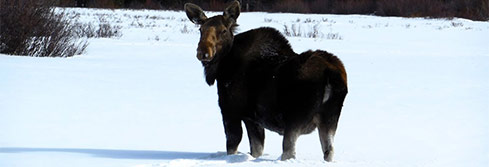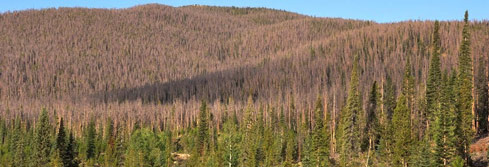Learn more about research being conducted by our Mammals researchers on:

Black Bear
Black bears are the largest carnivores in the state. Due to environmental changes and residential expansion, encounters and conflict between humans and black bears are increasing in Colorado and across the country. A thorough understanding of the relationship between conflict rates, bear behavior and population dynamics will assist wildlife agencies in successfully reducing conflicts through management.
Black Bear Research Projects:
>> back to top

Elk
Elk serve as one of Colorado’s most ecologically and economically important mammals. Therefore, it is critical that wildlife managers have the information and tools they need to properly manage elk populations. This involves understanding changes in habitat, climate, predator communities, and human development and how these changes impact elk population demography and behavior.
Elk Research Projects:
>> back to top

Lynx
Lynx populations in Colorado plummeted in the late 1800s and early 1900s for various reasons, including general predator poisoning and unregulated trapping. The last known lynx was illegally trapped near Vail in 1974, a year after the state listed the lynx as endangered. In 1997, Colorado Parks and Wildlife undertook what was to become one of North America’s most high-profile carnivore reintroductions to date. Four years after the last lynx was released into the state in 2006, CPW deemed the initial lynx introduction effort a success. Research has now focused towards determining and maintaining the long-term success of the reintroduction. Learn more about lynx and Colorado’s successful lynx reintroduction in our Lynx Fact Sheet. Or, learn how to identify a lynx and report a lynx sighting.
Lynx Research Projects:
>> back to top

Moose
After successful reintroduction efforts, Colorado’s Shiras moose population exceeds 2,000 animals statewide. With stable to increasing and spatially expanding populations, moose can now be hunted in the state during regulated seasons. In order to make informed licensing decisions, wildlife managers need adequate and reliable data on moose populations in the state.
Moose Research Projects:
>> back to top

Mountain Lion
Mountain lions, also known as cougars or pumas, reign as Colorado's largest cat. However, in recent years, human and mountain lion interactions have increased, prompting research projects focused on testing potential management solutions and collecting information about mountain lion behavior and population dynamics. The results of this research will also help wildlife managers set harvest quotas.
>> back to top

Mule Deer
Mule deer populations in Colorado have shown dramatic fluctuations since the 1960s. Beginning in the 1990s, some western Colorado mule deer herds demonstrated the most recent decline. As such, CPW focused research efforts on developing management techniques to increase the health and survival of mule deer, an economically and ecologically important game animal.
Mule Deer Research Projects:
>> back to top

Snowshoe Hare
Understanding and monitoring snowshoe hare density in Colorado is important because hares comprise 70% of the diet of the state-endangered, federally threatened Canada lynx. Forest management is an important driver of snowshoe hare density, and all National Forests in Colorado are required to include management direction aimed at conservation of Canada lynx and snowshoe hare.
Snowshoe Hare Research Projects:
>> back to top

Wildlife Response to Bark Beetles
Since 1996, millions of acres of Colorado forests have fallen victim to bark beetle infestations. This unusual epidemic has prompted CPW to focus research efforts on how wildlife are responding to these outbreaks.
Bark Beetle Research Projects:
>> back to top

